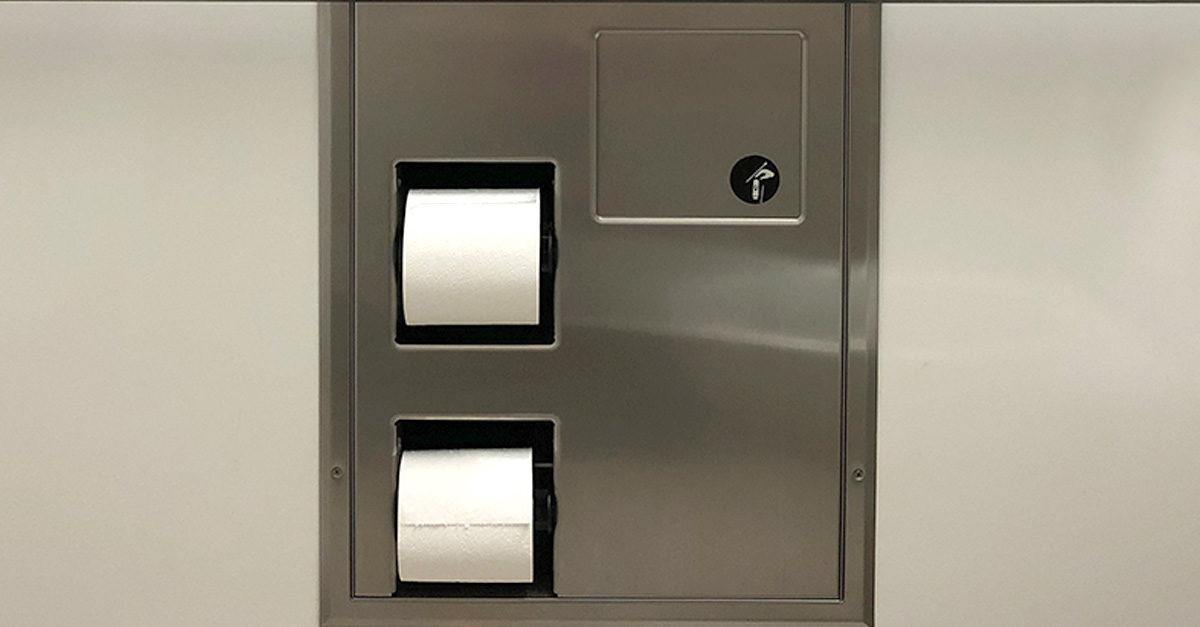It’s one of the most hazardous spots in the women’s restroom — it’s also the one nobody wants to talk about.
Typically emptied daily, but thoroughly cleaned only sporadically or not at all, the metal or plastic hinged trash bin in a restroom stall is the commonly accepted system for the disposal of soiled feminine care products. Studies show that this receptacle poses the greatest health risk in the restroom to patrons and staff.
The U.S. Occupational Safety and Health Administration (OSHA) reports that 5.6 million employees in the United States are at risk of exposure to bloodborne pathogens in the workplace. Building management and cleaning professionals must take responsibility for finding solutions that minimize the risk of contact with blood, bacterial contaminants, and bodily fluids. For many employees, that risk becomes greatest in the restroom, especially for cleaning staff who must handle bloodstained items just to complete daily cleaning tasks.
A fascinating finding comes from Dr. Charles Gerba, University of Arizona Microbiology Department, who has studied restroom contaminants for over 20 years. According to Gerba, the No. 1 bacterial hot zone in a female restroom is the sanitary napkin disposal unit.
Gerba discovered that an invisible mist coats the floor and partition walls every time the toilet flushes, contaminating all stall fixtures including the “sanitary” disposal units. This mist can include microorganisms such as the hepatitis A virus, E. coli, salmonella, cryptosporidium, staphylococcus, and C. difficile. These pathogens can survive for months on sanitary napkin disposal units unless these units are regularly and properly sanitized.
Facility management generally includes emptying these units on the daily janitorial checklist, but rarely does that checklist include proper sanitation of the inside and outside of these units with daily cleaning.
Research Supports Speculation
A study conducted by Ethox International Inc., STS Life Sciences Division for The Scensible Source Company LLC, tested for the presence of microorganisms on sanitary napkin disposal units at a variety of public facilities. Researchers found 100 percent of the sanitary napkin disposal units tested positive for bacteria or mold growth. Furthermore, the interiors of the unlined sanitary napkin disposal units yielded a significantly higher level (more than 10 times) of microbiological contamination than the exterior surfaces. Both hepatitis B and C can thrive in blood-soaked materials and in residue on restroom fixtures left behind by infected individuals.
According to the U.S. Centers for Disease Control and Prevention (CDC), the hepatitis B virus infects more than one million Americans — many of who do not even know they are infected. The virus is extremely hardy; it can survive in a drop of blood or bodily fluid or even on a dry surface for weeks and still be capable of causing infection. The hepatitis C virus may survive on environmental surfaces at room temperature for up to four days. Both viruses can enter the body through direct contact with broken skin.
Since it is impossible to identify infected individuals before they use the restrooms, it must be assumed that any and all soiled feminine care products may contain bloodborne pathogens. Hepatitis Foundation International recommends that bloodstained materials such as tampons and menstrual pads be placed into sealed plastic bags before they go into waste receptacles.
Facility management would be well-advised to treat all materials containing blood and bodily fluids, including menstrual blood, as if they are infected and potentially harmful to the health of patrons and cleaning staff. However, outside of health care facilities, there are no regulations in place to protect cleaning staff from exposure to blood or other potentially infectious materials.
OSHA guidelines simply dictate that feminine care products be discarded in waste containers that are properly lined with plastic or waxed paper bags to protect the cleaning crew from coming into direct contact with them. The agency does, however, state that it is the employer’s responsibility to take further steps to reduce health risks.
Guidelines provided by ISSA echo the OSHA standard, noting that bodily fluids and secretions do not qualify as regulated waste under the Bloodborne Pathogens Standard, but danger could exist. ISSA reminds employers that, ultimately, it is their responsibility to take all necessary action to protect employees from such exposure.
The 21st Century Solution
The most effective ways to protect patrons and custodial staff involve eliminating contact with materials and surfaces that may harbor bacteria. Follow these tips:
- Line sanitary disposal units with properly fitting plastic bags to ensure that all discarded products are self-contained.
- Properly disinfect the inside and outside of the unit each time the liner bags are changed.
- Make sure custodial staff always wear gloves while emptying and cleaning the receptacles.
- Teach cleaning staff to never reach into the receptacles.
- Emphasize staff hand-washing to minimize the risk of disease transmission
Ideally, building management will eliminate the need for these disposal units by moving to single-use sanitary product disposal bags and making them available in every restroom stall. In keeping with the move to low-touch restrooms, it stands to reason that sanitary product disposal must follow suit. It’s time to get rid of the dirtiest item in women’s restrooms and replace it with a system that earns the moniker of “sanitary.”



